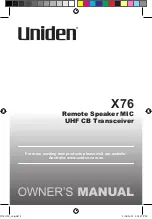
| 85
Measurement |
Argus Radar Operator Manual
¼
Note:
On the keyboard, the EBL and VRM can be adjusted with two (encoders) placed at the
bottom corners of the panel. Making the adjustments from the keyboard is more accurate
and we suggest using this method instead of dragging the markers.
The “EBL n” button is affixed by “R” (Relative) if it is relative to own ship’s heading, or “T” (True) if
it is referenced to the North. The visualization mode can be changed by pressing this button
and it will toggle between “T” and “R”.
In order to measure the distance between two echoes, it is possible to move the ERBL out
of the centre of the PPI. This operation can easily be performed just by dragging the centre
of the ERBL to the first echo, using the centre SK (only in PPI mode). In the same way, drag
the VRM over the second echo and the range value will represent the distance between the
echoes. To move the ERBL back to the centre of the PPI, just press the “Off Cent” labelled but-
ton next to the selected ERBL.
¼
Note:
This measurement mode allows to get an accurate measurement and the operator has
to utilise this mode when the situation requires precise data.
It is important to use maximum range to ob-
tain the best precision for the measurement.
The right scale must be selected in order to
see the target at the maximum range where
visible, so that the measurement is close at
its maximum accuracy. In order to increase
the measurement precision, it is advisable
to place the PPI in OFF Centre mode. In this
way the range can be increased and there-
fore the precision as well.
The VRM provides a more accurate measure-
ment of the range to an echo. The two VRMs
will be visualised on the PPI as dashed rings,
so that the operator will be able to dis-
criminate them from the fixed range rings.
The two VRM rings can be distinguished by
different colors and different type of dashes:
The selected one is white and dot-dashed,
the other one is cyan and only dashed.
When the ERBLs (1 or 2, or both) are not used, the operator can turn them OFF by performing
the same procedure used to turn them ON.
More target data measurement
The two ERBLs can be used at the same time in order to perform special operations, such as:
1.
Control the anti-collision manoeuvre. As explained in the previous paragraph, the origin of
the EBL can be placed anywhere, by means of the trackball, in order to get measurements
between targets (bearing and range). This facility can be utilised in order to verify a potential
risk of collision. The operator should place the EBL origin on the echo of interest and after
at least three minutes, rotate the EBL until it bisects the echo at its new position. The EBL
readout will display the ship’s course, true or relative (depending on the type of presentation
selected). If Relative Motion is selected, it will be possible to calculate the CPA as well. If the
EBL passes through the origin (own ship), the echo is on collision course. The second ERBL
can be switched ON to measure the distance between own ship and the EBL aligned with the
course of the echo: that’s the CPA.
2.
Observe any danger under way or in convoy areas. By means of the EBL function, which allow
to place the origin anywhere, it is possible to set the two ERBLs in order to define a Guard
Zone or to observe the ship’s course or distance from the coast or from possible danger to
the navigation.
Summary of Contents for ARGUS FMCW 3G
Page 1: ...ENGLISH ARGUSRADAR SYSTEM User Manual navico commercial com...
Page 2: ......
Page 149: ......
Page 150: ...988 10185 004...
















































